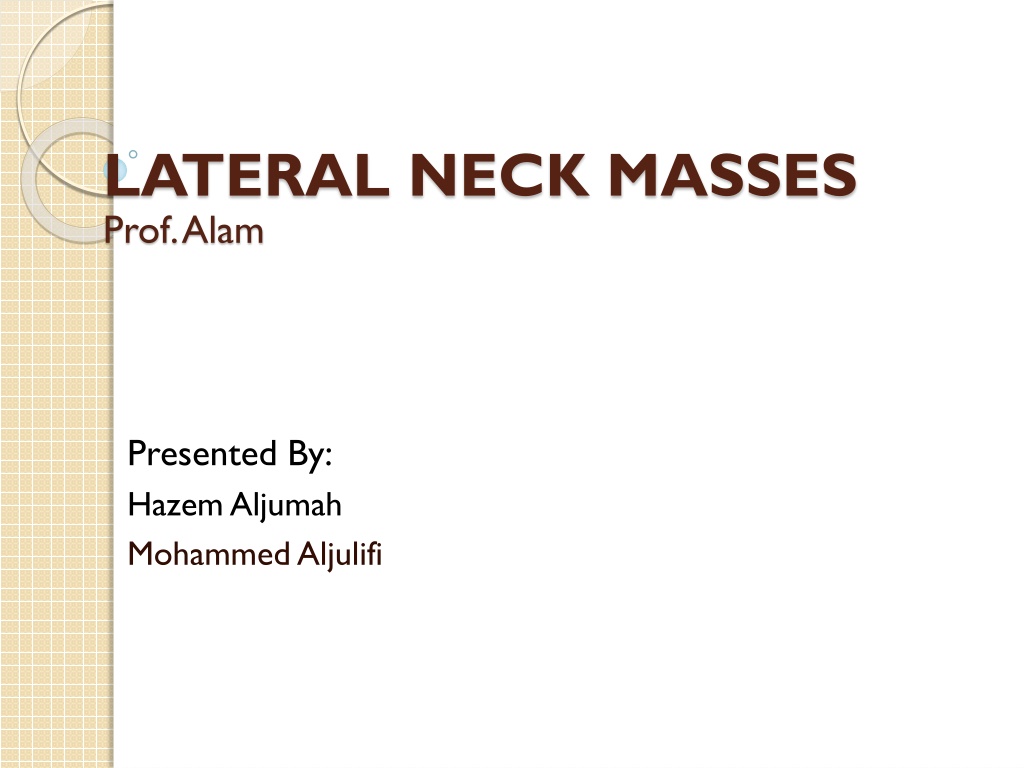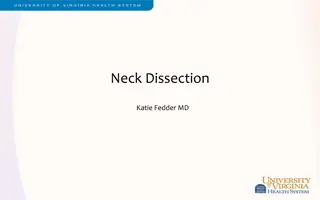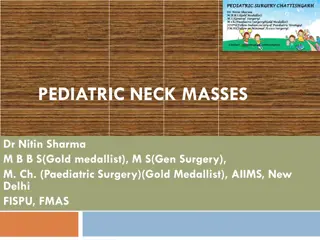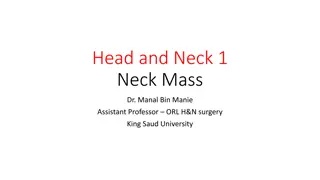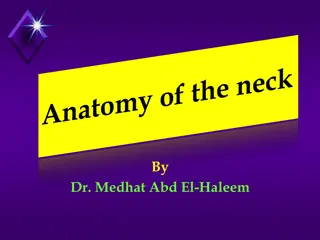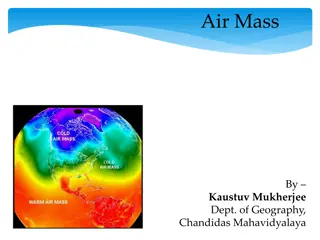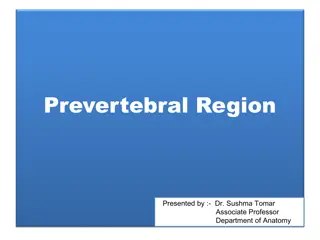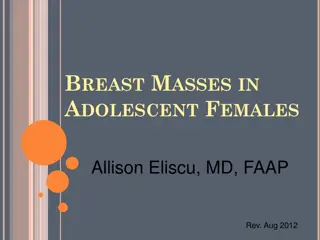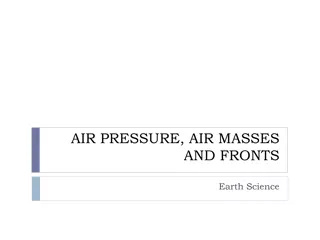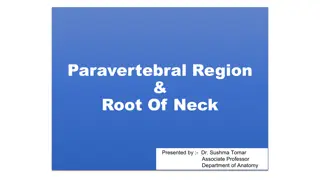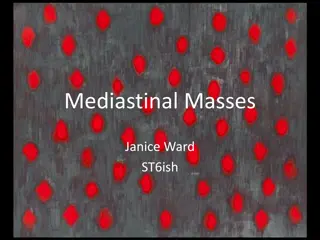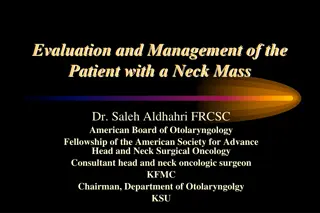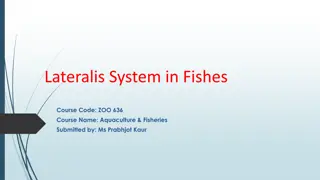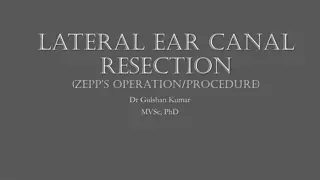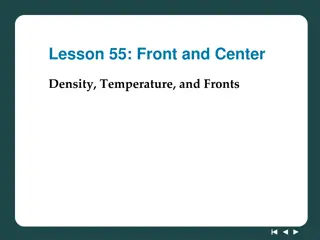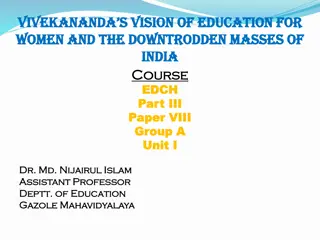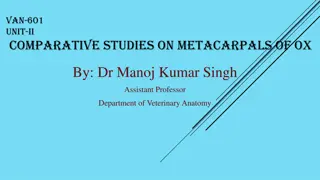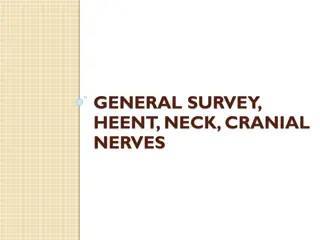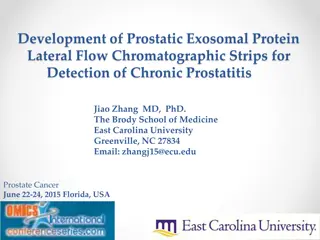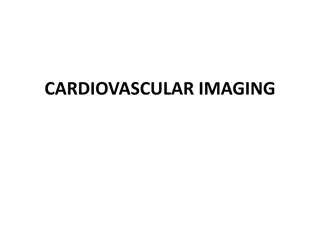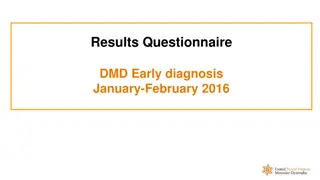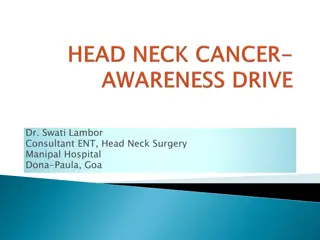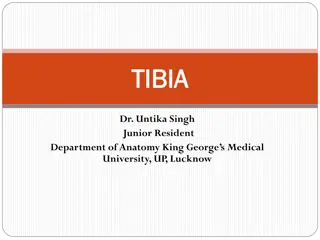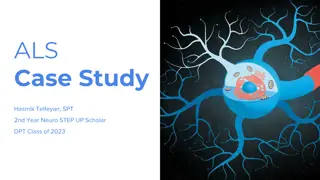Understanding Lateral Neck Masses: Anatomy, Diagnosis, and Management
Explore the anatomy and lymphatic drainage of the neck to effectively approach and differentiate various lateral neck masses. Learn about the anterior and posterior triangles of the neck, common neck mass differentials, and the significance of lymph nodes in neck pathology.
Download Presentation

Please find below an Image/Link to download the presentation.
The content on the website is provided AS IS for your information and personal use only. It may not be sold, licensed, or shared on other websites without obtaining consent from the author. Download presentation by click this link. If you encounter any issues during the download, it is possible that the publisher has removed the file from their server.
E N D
Presentation Transcript
LATERAL NECK MASSES Prof. Alam Presented By: Hazem Aljumah Mohammed Aljulifi
Objectives: Anatomy & lymphatic drainage of the neck How to approach a patient with a neck mass. Differential diagnosis of a neck mass. Examples of common lateral neck masses.
Anatomy of the neck:- The most important landmark: Sternocleidomastoid muscle. It divides the neck into anterior & posterior triangles. the anatomy of the neck helps us in the differentiates of each region by knowing contents of the region.
Anatomy of The Neck The Anterior Triangle: Superiorly : the border of the mandible. Medially : The Midline. Laterally : Ant. Border of the SCM Subdivide into : Submental triangle : formed by the anterior belly of the digastric, hyoid, and midline . Submandibular /digastric triangle : formed by the mandible, posterior belly of the digastric, and anterior belly of the digastric . Carotid triangle : formed by the superior belly of the omohyoid, SCM, and posterior belly of the digastric ( mostly vascular tumors) Muscular triangle : formed by the midline, superior belly of the omohyoid, and SCM . ( has no significant structures > no swellings )
Anatomy of The Neck The Posterior Triangle : Inferiorly : The Clavicle. Anteriorly : Post. Border of the SCM . Posteriorly : Ant. Border of the Trapezius. Subdivided into ( divided by the inf. Omohyiod muscle ) : Occipital triangle : SCM medial , Ant. Border of the Trapezius lateral , Inf omohyoid inferiorly. Supraclavicular triangle : clavicle inf. , SCM medial , Inf. Omohyoid superiorly.
Lymph Nodes of the Neck Level I submental, submandibular Level II upper jugular Level III middle jugular Level IV lower jugular Level V posterior jugular Level VI paratracheal, perithyroidal
Lymph Drainage Level I (Submandibular / Submental) Drains the lip, oral cavity & submandibular gland. Level II (Upper jugular) Drains the nasopharynx, oropharynx, parotid, & the supraglottic larynx. Level III (Mid jugular), IV (lower juglar) Drains the oropharynx, thyroid Level V (post. Cervical) Drains nasopharynx, thyroid Level VI (paratracheal) Drains cervical oesophagus and thyroid
History Age Pediatric(0-15):90% benign Young adult(16-40):as pediatric Elderly(>40):consider malignant until proven otherwise.
History (continued) Swelling: o Duration o Location o How was it noticed o Size o Shape o Skin changes, discharge o Painful or not o Other swellings in the body
History (continued) Associated Symptoms: o Dysphagia, odynophagia o Breathing difficulties o Hoarseness of voice or dysphonia o Otalgia, nasal discharge o Constitutional: fever, night sweats, wt loss, anorexia o If supraclavicular LN: ask pulmonary, GIT, GU symptoms o Oral or skin lesion
Risk factors Tobacco, alcohol Exposure to radiation Previous Hx of cancer Family Hx of head & neck CA URTI or dental problem Hx TB or contact with sick pt
Examination Scalp & face Ex for skin cancer Ear: external auditory canal and tympanic membrane Nasal Ex. Mucosal surface of oral cavity & oropharynx Motor & sensory Ex of the face
Examination (continued) Neck: 1. Swelling 2. Ex of other LN 3. Thyroid gland Ex. Respiratory & abdominal Ex.
Investigations Laboratory test: CBC with ESR Serology: monospot, toxoplasma, HIV, PPD Thyroid function test ANA
Investigations (continued) Imaging: Chest x-ray CT MRI US Radionuclear scan FNA Excisional biopsy
CT scan Distinguish cystic from solid masses Extent of lesion Vascularity (with contrast) Detection of unknown primary (metastatic) lesion Pathological LN node (lucent, >1.5cm, loss of normal shape) Avoid contrast in thyroid lesions
MRI Similar information as CT Better for upper neck & skull base Useful in defining deeply invasive tumors of tongue, pharynx and larynx Vascular delineation with infusion
Ultra sound Less important now with FNAB Solid versus cystic masses Congenital cysts from solid nodes/tumors Noninvasive (pediatric)
Radio nuclear Scan Salivary & thyroid masses Location glandular versus extra- glandular Functional information
Fine needle aspiration (FNA) Standard of diagnosis Indications: Any neck mass that is not an obvious abscess Persistence after a 2 week course of antibiotics Small gauge needle: Reduces bleeding Seeding of tumor not a concern Can be used to Dx carcinoma without illuminating the primary source, inadequate to define lymphoma Contraindications - vascular ?carotid body tumor
Panendoscopy FNAB positive with no primary on repeat exam FNAB equivocal/negative in high risk patient Directed Biopsy All suspicious mucosal lesions Areas of concern on CT/MRI None observed random biopsy of nasopharynx, tonsil (ipsilateral tonsillectomy for jugulodigastric nodes), base of tongue
Open excisional biopsy Only if complete workup negative Occurs in ~5% of patients Be prepared for a complete neck dissection. Frozen section results (complete node excision): Inflammatory or granulomatous culture Lymphoma or adenocarcinoma close wound
80s simple rule for solitary neck mass If benign tumors of the thyroid gland are excluded, nearly 80% of neck mass in adults are malignant. 80% are metastatic 80% arise from primary sites above the clavicle. 80% are metastatic SCC.
Midline Neck Masses EXAMPLES: 1. Dermoid cyst. 2. Thyroglossal Duct Cyst.
Carotid body tumor What is the carotid body? is a small cluster of chemoreceptors and supporting cells located near the fork (bifurcation) of the carotid artery (which runs along both sides of the throat).
Carotid body tumor - (chemodectomas) tumors arising from chemoreceptor tissue. Also called as Paragangliomas - Carotid body tumor is the most common of the head and neck paragangliomas - Could be benign(most common) or malignant
Carotid body tumor Presentation: Rare in children, common in 4th/ 5th decade (common in 50s).. In areas with high altitude It usually presents as a painless neck mass larger tumors may cause dysphagia, airway obstruction, and cranial nerve palsies, usually of the vagus nerve and hypoglossal nerve
Carotid body tumor Features: Approximately 3% are bilateral. This tumor increases to 26% in patients with a familial tendency for paragangliomas Usually it compressible mass. Mobile medial/lateral not superior/inferior The mass may be pulsatile & may have a bruit.
Carotid body tumor Diagnosis: confirmed by angiogram or CT angiography shows tumor blush at the carotid bifurcation FNA or biopsy are contraindicated Nowadays mostly by CTA(CT angio)
Carotid body tumor Treatment: - By surgical excision. But large tumors may require carotid bypass. - Irradiation or close observation in the elderly. - Surgical resection for small tumors in young patients Hypotensive anesthesia Preoperative measurement of catecholamines
Lymphadenopathy Causes: They are best recalled with the use of the mnemonic MINT
Lymphadenopathy M: Malformations include sickle cell anemia and other congenital hemolytic anemias , the reticuloendothelioses like Gaucher disease I: Inflammatory: the largest group of lymphadenopathies Viral illnesses: infectious mononucleosis, German measles, chickenpox, & viral upper respiratory illnesses Rickettsial disease: typhus & rocky mountain spotted fever
Lymphadenopathy Bacterial diseases:Acute Bacterial lymphadenitis, typhoid, plague, tuberculosis , meningococcemia, & brucellosis Spirochetes: syphilis & borrelia vincentii. Parasites: malaria, filariasis, & trypanosomiasis Fungi: histoplasmosis, coccidioidomycosis, & blastomycosis Common after upper respiratory tract infection
Lymphadenopathy N:Neoplasms like leukemias , lymphomas & metastasis from H&N T:Toxic disorders like Dilantin toxicity may mimic Hodgkin disease and drug allergies from sulfonamides, hydralazine, & iodides In addition to disorders like SLE, sarcoidosis
Lymphadenopathy Investigations CT , MRI & US for evaluation of mass & staging FNA is sensitive & specific Management: according to cause Inflammatory: by Abx. Neoplastic: If metastasis, surgical excision of lymph node If leukemia or lymphoma: radiotherapy or chemotherapy
Branchial Cleft Cysts Definition: A branchial cyst is a cavity- a congenital remnant from embryologic development.
Branchial Cleft Cysts - It is present at birth usually on one side of the neck located just in front of the sternocleidomastoid muscle. -The commonest cause: incomplete disappearance of site of fusion between the 2nd & the 5th pharyngeal pouch - may not present clinically until later in life, usually by early adulthood
Branchial Cleft Cysts -The most common congenital masses in the lateral neck - include cysts(most commonly), sinuses, & fistulae, may present anywhere along the SCM muscle -The most common is the 2nd - Usually appears adulthood
Branchial Cleft Cysts 2nd Identified along the anterior border of the upper third of the SCM muscle & adjacent to the muscle. tract medial to between internal and external carotids. cleft most common (95%) CNXII 1stcleft less common in the region of the parotid gland, sternocleidomastoid. with facial nerve possible ear or association high close 3rdand 4thclefts rarely reported
Branchial Cleft Cysts History A branchial cyst commonly presents as a solitary, painless mass in the neck of a child or a young adult. A history of intermittent swelling and tenderness of the lesion during upper respiratory tract infection may exist. Discharge may be reported if the lesion is associated with a sinus tract. In some instances, branchial cleft cyst patients may present with locally compressive symptoms. A family history of branchial cleft cysts may be present
